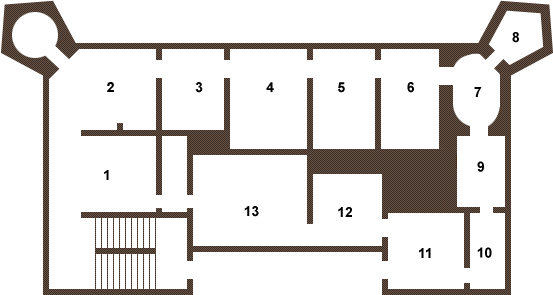Evacuation
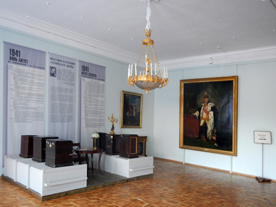
In the tragic years of wartime Seraphima Nikolaevna Balaeva organized and inspired the Leningrad museum workers. Up until September 1941, she was responsible for evacuating the art collections from the Gatchina Palace, then she led efforts to preserve art objects relocated to St Isaac’s Cathedral for storage.
Western European Painting
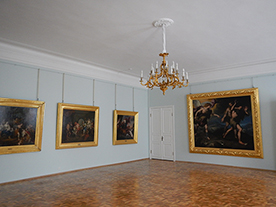
The collection of paintings at the Gatchina Palace was begun by Count Grigory Orlov. The collection expanded with new additions by each successive owner. Thus, by 1917 the Gatchina holdings had grown to become one of the most extensive in Russia, consisting of over 3000 paintings.
The gallery features work of the 17th and 18th century European masters, some of the pictures come from the original collection which were acquired by the palace’s initial owners.
Portrait painting of the first half of the 18th century

The European masters employed in Russia greatly influenced the national painting school. Representing a variety of schools such as French, Italian or German, they gave an impetus to the development of secular art and also provided training for Russian artists. The rapid development of secular portraiture began in the Petrine era.
The gallery displays some interesting pioneering works by Russian painters from the early 18th century - the portraits of tsarinas Natalia Kirillovna and Marfa Matveevna.
Portrait painting of the second half of the 18th century

The nobility of the Russian Empire flourished under Catherine II (1762-1796), which resulted in the rapid evolution of portrait painting. The pictures on display make it possible to trace the history of Catherine’s reign through portraits of the people who surrounded the empress.
These include the dethroned Emperor Peter III, Count A.G. Bobrinsky - Catherine’s illegitimate son, the brothers Orlovs and G.A. Potemkin - Catherine’s favourites, as well as officials and military leaders - Field-Marshal A.V. Suvorov and Count I.E. Fersen.
Room of Pietro Antonio Rotari
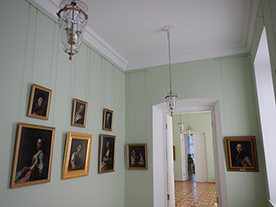
The celebrated Italian painter Pietro Antonio Rotari (1707 – 1762) is best known in the arts for a multitude of exquisite “female heads”.
Catherine II gifted a collection of Rotari’s works to Count Orlov. The Rotari Room was introduced at the Gatchina Palace as part of the palace’s remodeling under Nicholas I, with works by the famous Italian being its main decorative feature.
On display in the room are both his well-known heads and portraits of princes of Saxony, the sons of Augustus III.
The intimate portrait in the second half of the 18th century
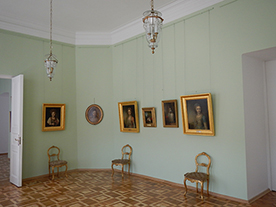
Women’s and children’s portraits held a particular place in the painting of the second half of the 18th century. The Austrian artist J.B. von Lampi the Elder and the Russian portraitist V.L. Borovikovsky created a whole gallery of images depicting fair ladies from the Romanov family.
The room features images of Paul I’s wife, his daughters and his sister-in-law. The life of each character makes it possible to trace the close dynastic links between Russia and Europe.
Portraits of high society in the 19th century

The room features work characteristic of the period by George Dawe, Franz Xaver Winterhalter and Franz Kruger. These artists gained popularity in their lifetime and were truly “fashionable” painters.
Among the finest paintings from the original collection at the Gatchina Palace is the portrait of Grand Duchess Anna Pavlovna, the future Queen of the Netherlands, by the Revel artist K.Z. Valter.
Paul I’s Lower Throne Room
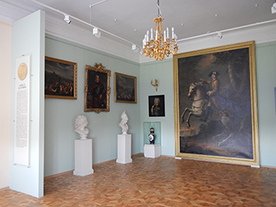
Paul I’s Lower Throne Room was located on the ground floor in the Main Building of the palace.
Until 1941 the appearance of the Throne Room was preserved as it was in the spring of 1800 during Paul’s last visit to the palace.
The most prominent element in the decoration was an enormous – from ceiling to floor – equestrian portrait of Peter I, which is now on view. This work is now attributed to the French painter J. Jouvenet.
The War of 1812 Memorial Hall

Numerous monuments were created to commemorate the Russian army’s victory in the Patriotic war of 1812, the most important of which is the famous military gallery at the Winter Palace in St. Petersburg.
After Nicholas I ascended the throne, the Gatchina Palace acquired its own hall commemorating the victory in the Patriotic war of 1812. The portraits by George Dawe were placed in the Yellow Hall on the second floor of the Main Building.
Great Military Study of Nicholas I
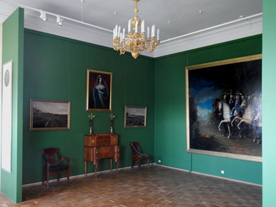
Following the remodeling of the palace, Nicholas I’s private rooms were located on the ground floor of the Arsenal Wing. The apartments were furnished in keeping with the Emperor’s preferences. Nicholas was fond of military science and was well versed in it.
The most important feature in the decoration was the painting Paul I and his Suite (1802) by J.B. Lampi (Jr.), which entered the collection in 1840. Henry Gambs, a renowned St Petersburg-based cabinet-maker, supplied the furniture for Nicholas’ apartments. He constructed a set of chairs to furnish the study and a bureau that still bears an inscription on its back “The Tsar’s Study” and is now on display in the room.
Alexander’s Reception Rooms
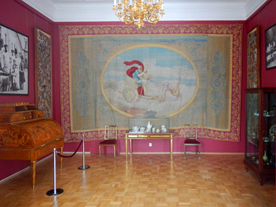
There were four state reception rooms in the Gatchina Palace, where Alexander III received delegations of nobles, foreign ambassadors, ministers, and dignitaries.
Most of the furnishings from the reception rooms have survived World War II. The fine tapestries and embroideries are of particular value, including among those the tapestry Saturn produced in 1805-1806. The artworks that were largely unscathed include paintings, decorative panels of the late 17th and early 18th centuries, porcelain, and decorative bronze pieces, which are now on view in the gallery.
Arsenal Hall
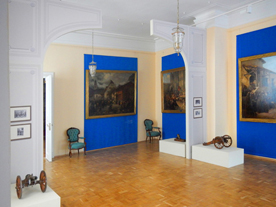
Throughout its history from the 18th century onwards, the Arsenal Hall located on the ground floor was the focal point around which social and family life revolved. The hall took on its final appearance during the reign of Nicholas I. This was the venue for Sunday and gala dinners, during which music was played. The walls were hung with watercolors by M. Zichi, some of which had handwritten inscriptions by Alexander III noting who was depicted. There were also many artworks, a stage for a domestic theatre, a children’s wooden slide, and swings shaped as a boat.
